
Elemente der Mathematik
Scope & Guideline
Unlocking the potential of mathematics for all scholars.
Introduction
Aims and Scopes
- Geometric Properties and Theorems:
This area includes studies on geometric transformations, properties of polygons, and advanced geometric constructions, highlighting the foundational aspects of geometry. - Algebra and Number Theory:
The journal publishes research on algebraic structures, number-theoretic identities, and polynomial equations, showcasing the interplay between algebra and geometry. - Analytical Methods and Complex Analysis:
Papers often explore analytical techniques and complex analysis applications, including proofs and identities that bridge various mathematical fields. - Mathematical Inequalities and Relationships:
A significant focus is placed on deriving and exploring inequalities in various mathematical contexts, which is crucial for both theoretical insights and practical applications. - Historical and Cultural Contexts in Mathematics:
The journal also addresses the historical development of mathematical concepts, providing insights into the cultural and educational significance of mathematical discoveries. - Interdisciplinary Approaches:
There is an emphasis on interdisciplinary research that connects mathematics with fields such as computer science, physics, and engineering, reflecting the diverse applications of mathematics.
Trending and Emerging
- Advanced Geometric Analysis:
There is a notable increase in papers that delve into advanced geometric constructs, including studies on polygons, transformations, and their properties in higher dimensions. - Complex Analysis and Its Applications:
Research involving complex analysis has surged, particularly in relation to proofs and applications that connect various mathematical domains, reflecting a growing appreciation for analytical techniques. - Inequalities and Their Applications:
An emerging trend is the exploration of new inequalities and their implications in various fields, which is vital for both theoretical advancements and practical problem-solving. - Interdisciplinary Mathematical Applications:
Papers that connect mathematics to other disciplines, particularly computer science and physics, are on the rise, indicating a trend towards collaborative and applied mathematical research. - Explorations of Mathematical Properties:
There is an increasing focus on the exploration of unique mathematical properties, such as those related to primes and integer solutions, which suggests a deeper investigation into number theory.
Declining or Waning
- Elementary Geometry:
Papers focusing on basic principles of elementary geometry have decreased, suggesting a shift towards more complex and abstract geometric studies. - Historical Mathematics:
Although historical perspectives were once prevalent, the number of papers dedicated solely to historical analysis or biographies of mathematicians is declining. - Basic Mathematical Concepts and Foundations:
There seems to be a waning interest in purely foundational topics, as recent publications lean towards more advanced and specialized areas of research. - Pedagogical Studies in Mathematics:
Research centered on educational methodologies and teaching strategies in mathematics is less frequent, indicating a potential shift away from pedagogical discussions.
Similar Journals

Cambridge Journal of Mathematics
Advancing Mathematical Frontiers with Every IssueCambridge Journal of Mathematics, published by INT PRESS BOSTON, INC, is a premier platform for the dissemination of cutting-edge research in the field of mathematics. With an ISSN of 2168-0930 and E-ISSN 2168-0949, this journal stands out in a competitive academic landscape, currently ranked #58 out of 399 in General Mathematics, placing it in the top 15% within its category according to Scopus metrics. The journal serves as a vital resource for researchers, professionals, and students alike, aiming to foster groundbreaking mathematical inquiries and foster collaboration across disciplines. Published from 2020 to 2024, the Cambridge Journal of Mathematics is committed to maintaining high standards of scholarship, making it an essential read for those who are passionate about advancing mathematical knowledge and its applications.
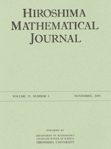
Hiroshima Mathematical Journal
Connecting Researchers Through Innovative Mathematical InsightsThe Hiroshima Mathematical Journal, published by Hiroshima University, Graduate School of Science, serves as a prominent platform for disseminating high-quality research in the field of mathematics. Established in 1959, the journal has been an integral part of the mathematical community, focusing on areas such as Algebra, Number Theory, Analysis, and Geometry and Topology. Although currently classified in Q4 quartile rankings within its categories, the journal is committed to advancing mathematical knowledge and fostering scholarly dialogue. Its accessibility, combined with its long-standing history, makes it an essential resource for researchers, professionals, and students dedicated to exploring and enhancing the mathematical sciences. For those interested in contributing or accessing cutting-edge research, the Hiroshima Mathematical Journal continues to uphold its mission of excellence in mathematical scholarship.
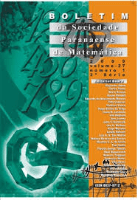
Boletim Sociedade Paranaense de Matematica
Championing Open Access in Mathematical ResearchBoletim Sociedade Paranaense de Matematica is a distinguished journal within the field of Mathematics, published by the Sociedade Paranaense de Matemática in Brazil. With an ISSN of 0037-8712 and an E-ISSN of 2175-1188, this journal has been committed to fostering open access to mathematical research since 2002, ensuring that cutting-edge research is readily available to the academic community. Operating within the diverse landscape of mathematical studies and ranked Q3 for 2023 in the category of Mathematics (Miscellaneous), the journal serves as a platform for innovative contributions and discussions. It ranks 192nd out of 399 in the Scopus database for General Mathematics, reflecting its steady involvement in the global academic dialogue. The Boletim resides at JD AMERICAS, CAIXA POSTAL 19081, CURITIBA PR 81531-990, Brazil, and aims to connect researchers, practitioners, and students by promoting high-quality research and dissemination of mathematical knowledge. By bridging diverse mathematical theories and applications, the journal not only enhances understanding of the discipline but also drives future research directions.

Advanced Studies-Euro-Tbilisi Mathematical Journal
Advancing Mathematical Knowledge GloballyAdvanced Studies-Euro-Tbilisi Mathematical Journal, published by the esteemed TBILISI CENTRE MATH SCI, is a vital resource for scholars and practitioners in the field of mathematics. Since its inception in 2021, this journal has committed to advancing knowledge across various mathematical disciplines, including Algebra and Number Theory, Analysis, Applied Mathematics, and Geometry and Topology, although it currently holds a category quartile ranking of Q4 in all these areas. With an open-access format, it provides unparalleled access to cutting-edge research to a global audience of researchers, professionals, and students, fostering collaboration and innovation within the mathematical community. Operating from TBILISI, Georgia, the journal acknowledges the growing importance of diverse geographical contributions to mathematics and aims to spotlight emerging research trends. As research continues to evolve, Advanced Studies-Euro-Tbilisi Mathematical Journal seeks to enrich the academic dialogue and support the dissemination of mathematical knowledge.

INDIAN JOURNAL OF PURE & APPLIED MATHEMATICS
Cultivating Knowledge in the Mathematical SciencesINDIAN JOURNAL OF PURE & APPLIED MATHEMATICS, published by the INDIAN NATIONAL SCIENCE ACADEMY, stands as a vital resource in the realm of pure and applied mathematics since its inception in 1996. With ISSN 0019-5588 and E-ISSN 0975-7465, this journal aims to disseminate original research that advances the understanding and application of mathematical principles. Operating out of New Delhi, India, it serves a diverse readership comprising researchers, scholars, and practitioners in the mathematical sciences. Recognized within the Q3 category in both Applied Mathematics and Miscellaneous Mathematics as per the 2023 category quartiles, the journal emphasizes rigorous peer-reviewed articles that contribute to its impact in academia, reflected in its Scopus rankings. Although it does not currently operate as an open-access journal, it maintains a commitment to quality and accessibility of scholarly content, striving to foster academic collaboration and innovation. The convergence of full-text issues from 1996 to 2024 highlights its ongoing dedication to the evolution of mathematical research.
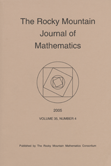
ROCKY MOUNTAIN JOURNAL OF MATHEMATICS
Navigating the Landscape of Mathematical DiscoveryROCKY MOUNTAIN JOURNAL OF MATHEMATICS, published by the Rocky Mountain Math Consortium, serves as a critical platform for researchers and practitioners in the field of mathematics since its inception in 1971. With a notable presence in the academic community, this journal covers a broad spectrum of mathematical disciplines, positioning itself in the Q2 category for Mathematics (miscellaneous) as of 2023. Despite being a subscription-based journal, it is recognized for its rigorous peer-review process and contributions to theoretical and applied mathematics, helping to advance knowledge and foster collaboration among mathematicians. The journal's ISSN number is 0035-7596 and its E-ISSN is 1945-3795, reflecting its commitment to accessibility and dissemination of high-quality research. Based in Tempe, Arizona, at Arizona State University, the journal continues to play an important role in shaping contemporary mathematical discourse through well-researched articles and innovative studies, aiming to bridge gaps between various mathematical subfields and engage a diverse audience, including students and established researchers alike.

Revista de la Union Matematica Argentina
Fostering Collaboration in Mathematical DiscoveryRevista de la Union Matematica Argentina is a distinguished open-access journal dedicated to the dissemination of innovative research in the field of mathematics. Published by Union Matematica Argentina, this journal fosters a collaborative environment for mathematicians from diverse subfields to share their findings and insights. With an ISSN of 0041-6932 and an E-ISSN of 1669-9637, it has been a valuable resource since its establishment, fully embracing open access since 2004. While currently positioned in the Q4 quartile of Scopus' rankings for Mathematics (miscellaneous) and holding the 314th rank in the general mathematics category, the journal serves as an important platform for researchers and professionals looking to contribute to or stay informed about the latest developments in mathematical sciences. Its editorial board is committed to rigorously peer-reviewed content, ensuring that published articles uphold high academic standards. With the aim of enhancing the visibility and accessibility of mathematical research in Argentina and beyond, the journal is essential for both established academics and emerging scholars within the global mathematical community.

Japanese Journal of Mathematics
Unveiling the Future of Mathematics ResearchThe Japanese Journal of Mathematics, published by SPRINGER, stands as a premier platform for the dissemination of high-quality research in the field of mathematics. With its ISSN 0289-2316 and E-ISSN 1861-3624, this prestigious journal has been continually contributing to the academic community since its inception. Spanning a broad range of mathematical disciplines, the journal enjoys a strong reputation, recognized in the 2023 category quartiles as Q1 in Mathematics (miscellaneous), placing it among the top-tier journals in the field. Its Scopus rank of #41 out of 399, which reflects an impressive 89th percentile, further underscores its influence and the quality of articles it publishes. The Japanese Journal of Mathematics is dedicated to fostering scholarly exchange and advancing mathematical research, making it an indispensable resource for researchers, professionals, and students alike. Although it does not offer open access, its comprehensive archives provide a wealth of knowledge for those seeking to deepen their understanding of mathematical theories and applications.
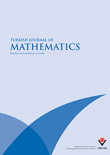
Turkish Journal of Mathematics
Fostering Excellence in Diverse Mathematical DisciplinesTurkish Journal of Mathematics is a prestigious academic publication dedicated to the advancement of mathematical research across a variety of subfields. Established in 1995 and published by the Tubitak Scientific & Technological Research Council Turkey, this journal has built a solid reputation, especially noted for its significant contributions to the field over the years, with its convergence spanning from 1995 to 2002 and again from 2006 to 2024. The journal, which holds a commendable Q2 ranking in Mathematics (miscellaneous) and is positioned in the 66th percentile of Scopus rankings for General Mathematics, aims to disseminate high-quality original research, reviews, and innovative methodologies to advance both theoretical and applied mathematics. Researchers, professionals, and students alike will find invaluable resources within its pages, providing insights that are pivotal for academic and practical applications in mathematics. Although it does not currently offer open access options, the journal remains an essential platform for those looking to engage with the forefront of mathematical inquiry.
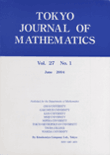
Tokyo Journal of Mathematics
Connecting Global Minds Through Mathematical ResearchTokyo Journal of Mathematics is a prestigious journal dedicated to the dissemination of high-quality research in the field of mathematics. Founded in 1978, this journal serves as a platform for researchers to publish their findings, providing cutting-edge insights into various mathematical theories and applications. Published by the TOKYO JOURNAL MATHEMATICS EDITORIAL OFFICE ACAD CENTER, the journal is based in Japan and forms an integral part of the global mathematical community. Although listed in the Q4 quartile of Mathematics (Miscellaneous) category for 2023, its inclusion in Scopus rankings highlights its ongoing commitment to scholarly excellence. The journal does not currently offer Open Access options, thus providing readers with insightful access to critical advancements in mathematics. With an ISSN of 0387-3870 and a publication history spanning over four decades, the Tokyo Journal of Mathematics remains an essential resource for researchers, professionals, and students alike, fostering the advancement of mathematical knowledge and collaboration across borders.